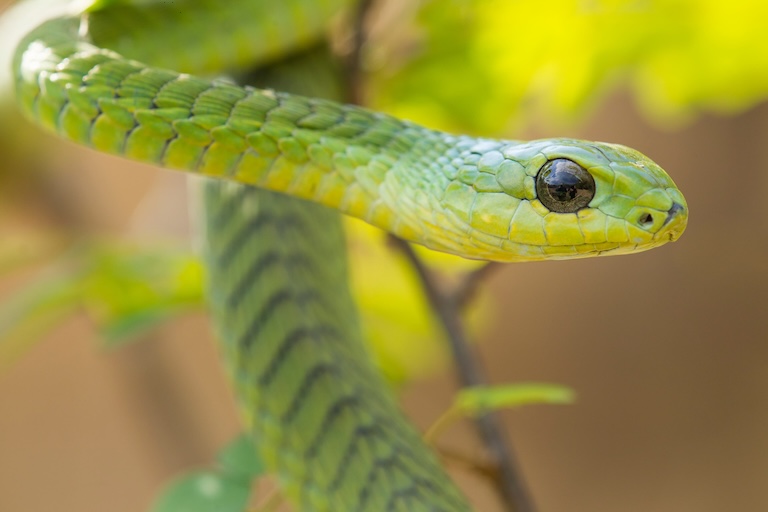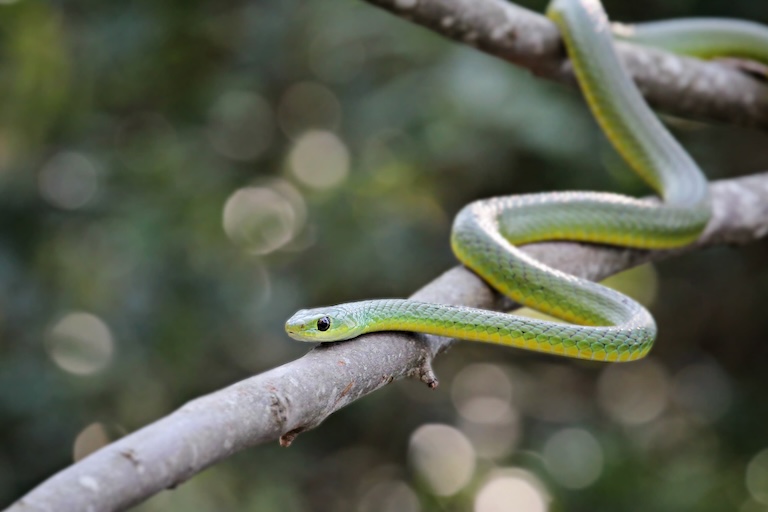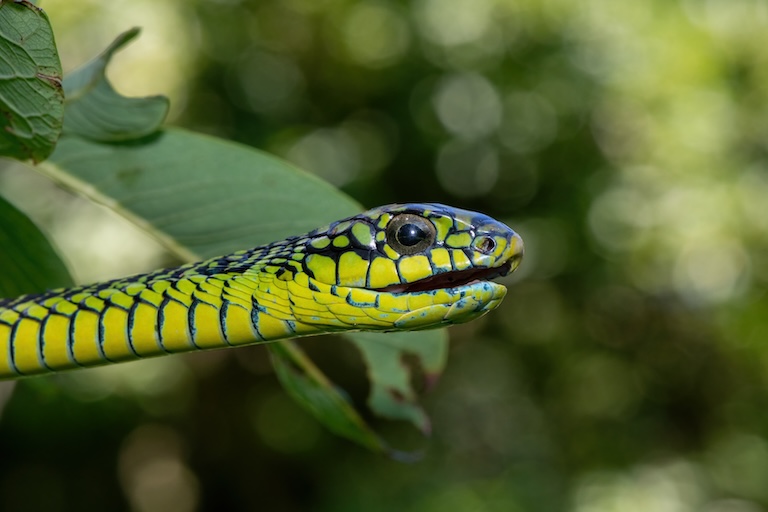Boomslang Profile
Snakes and humans go way back. 6000 years at least. And as a result, we’ve had time to develop a learned fear of them to pass on to our offspring.
The trouble with snakes is that, like mushrooms, some of the most innocuous can be the most dangerous. So, in many places where there are dangerous snakes, all snakes are feared equally, just in case.
But many species, even the most venomous ones, are quietly venomous, and have no desire to strike, even when handled. The boomslang is a great example of this.
A snake with an incredibly toxic venom, offset by exceptional beauty, and of no risk to anyone who will just leave it alone.

Boomslang Facts Overview
| Habitat: | Scrubs, savannas, lowland forests |
| Location: | Common in Sub-Saharan Africa |
| Lifespan: | 9 years in captivity |
| Size: | Up to 1.8m (6ft) long |
| Weight: | Around 500g (1.1lb) |
| Colour: | Usually green or yellow-ish, males greener, females more yellow |
| Diet: | Mostly arboreal lizards, also rodents, frogs, eggs and birds |
| Predators: | Other snakes, larger birds |
| Top Speed: | Fast |
| No. of Species: | 1 |
| Conservation Status: | Least Concern (IUCN) |
Boomslangs are extremely venomous colubrid snakes who are so good-looking it’s hard to stay frightened by them. And there’s really no need to be, either, because they are some of the most docile and inaccessible snakes you’ll see in Africa.
They keep to themselves in the trees, and even when you bother them, they are hesitant to lash out. Still, if you do somehow manage to piss one off, you’re going to have a really bad day or so, if you’re lucky enough to last that long.
Interesting Boomslang Facts
1. Tree snakes
Boomslangs are very glamourous animals. They range from brown to green on top but usually have a bright yellow belly and big, distinctive eyes.
They’re diurnal snakes and live in the trees, and this last part is where they get their name. In Afrikaans, boomslang means treesnake, and the boomslang is one of the most treesnakes. It rarely descends, and will hunt, sleep, mate and rest in the canopy.

2. They have a wide gape
There are a few things that make this snake a bit special, and a lot of them come from the mouth area. The mouth itself is very flexible and can open to 170 degrees when yawning or trying to bite your face off.
This is great for catching prey, but especially useful for a rear-fanged snake like this, as it allows them to unfold and present the prey item with the fangs themselves.
And if a bite is successful, most victims will be in serious trouble. 1
3. They’re surprisingly venomous
Boomslangs have a potent hemotoxic venom that generally works to prevent clotting and cause a victim to bleed to death. But there are other elements at play, and symptoms can sneak up on you.
In no case is this better summed up than researcher Karl P. Schmidt, who found out the hard way. On being bitten by a boomslang, the slow-acting venom appeared to have little effect, so instead of seeking help, he opted to document his experience.
Within 24 hours, he was dead. His notes included symptoms of nausea, vomiting, chills, bleeding gums and other lovely things. His last written words were, “No urine with an ounce or so of blood about every three hours. Mouth and nose continuing to bleed, not excessively”.
He was declared dead by respiratory paralysis, and this is to be expected from a bite from a boomslang, though a bite from a boomslang is by no means to be expected. 2
4. They’re shy
Boomslangs are very hesitant to strike. While they have crazy potent venom, it’s not meant for people or predators in general – it’s their hunting tool, and they’d rather hold onto it.
They have a timid nature, and while bites do occur, they are almost always in the event of someone catching, holding, kissing, or otherwise bothering the snake.
If cornered, the boomslang will threaten by flattening its neck and assuming the classic defensive posture. Still, they will try as much as possible not to strike. Add to this the fact that they stay well away from people and up in the trees, and they become much less dangerous in reality than in the imagination.

5. They’re fast
When they do strike, though, it’s certainly hard to see it coming. This is an active and fast species, nimble in the trees and fast in general.
They don’t hunt on the run often, preferring to ambush their prey, but when threatened they will flee very effectively. 3
6. They’re not very social
The rare instances when a boomslang will share a space with another boomslang either involved in snake-on-snake loving or snake-on-snake eating. This is a species that is happy to cannibalise, striking with lightning speed at anything small and unfortunate enough to cross its path.
At the other end of the order of things, boomslangs are also predated upon by other snakes, including vine snakes, which are notorious snake eaters. 4
7. They sometimes hibernate in nests
Boomslangs aren’t migratory, so in regions where it gets cold, they hunker down to ride it out. Researchers investigating the nests of weaver birds need to watch out because nests like this are a perfect hibernation spot for a chilled-out boomslang. 5
Boomslang Fact-File Summary
Scientific Classification
| Kingdom: | Animalia |
| Phylum: | Chordata |
| Class: | Reptilia |
| Order: | Squamata |
| Family: | Colubridae |
| Genus: | Dispholidus |
| Species: | typus |
Fact Sources & References
- “Dispholidus typus Boomslang”, Animal Diversity Web.
- Alexa Lim (2015), “He documented his own death by snakebite instead of going to the hospital”, The World.
- Grant Snake Ranger (2017), “Snake Lighting: Boomslang moves fast!”, YouTube.
- Maritz, R (2019), “Ophiophagy and cannibalism in African vine snakes”, African Journal of Ecology.
- “Boomslang”, Safaris Africana.
